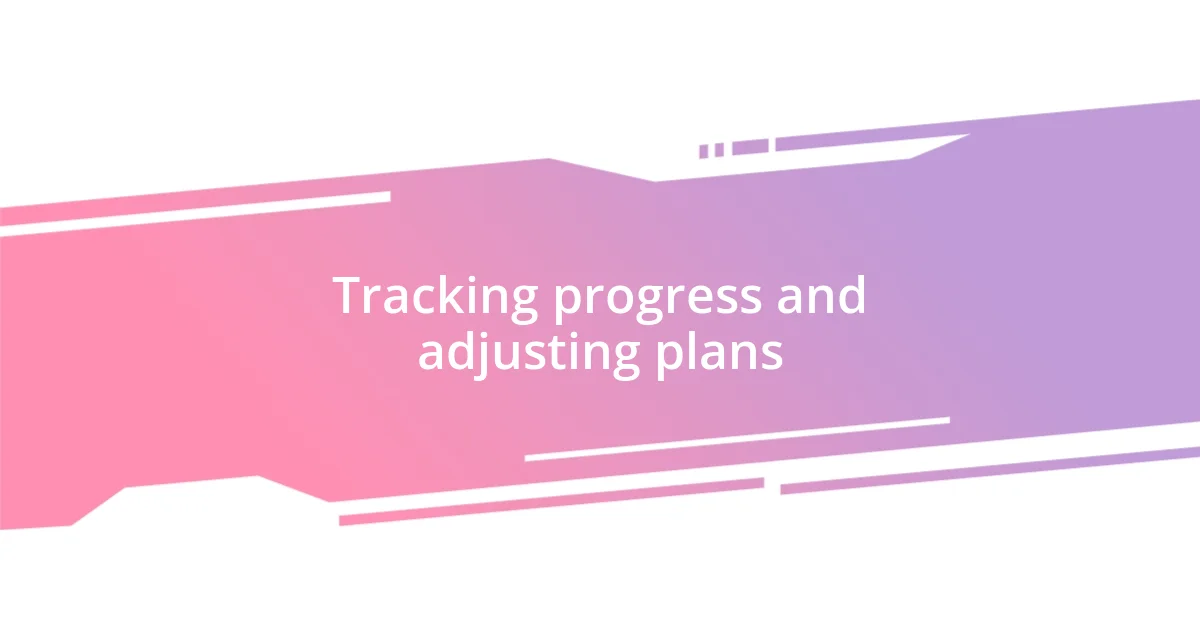Key takeaways:
- Self-reflection is crucial for defining financial goals, allowing a clear distinction between needs and wants while connecting ambitions to personal values.
- A flexible budgeting plan is essential for managing finances, incorporating both fixed expenses and discretionary spending, while allowing for adjustments based on life’s unpredictability.
- Celebrating financial achievements, no matter how small, reinforces motivation and transforms saving into an enjoyable journey, enhancing connections with friends and creating lasting memories.

Understanding your financial goals
Understanding your financial goals starts with self-reflection. I remember sitting down one evening, feeling overwhelmed by all my financial responsibilities. I asked myself, “What do I truly want in life?” This simple question opened doors to clarity, helping me differentiate between needs versus wants and prioritize my spending.
It’s essential to break down your goals into short-term and long-term aspirations. For instance, saving for a vacation next year versus planning for retirement may seem light-years apart, but they both require dedication and strategy. I found it rewarding to set achievable milestones, like saving a small percentage of my paycheck each month. Have you tried setting specific, time-bound goals? Seeing progress over time can be incredibly motivating and empower you to maintain a balanced approach to saving and living.
Moreover, understanding your financial goals isn’t just about the numbers; it includes emotions and desires. When I realized that my goal of buying a home was deeply tied to my desire for stability and comfort, I became inspired to prioritize my savings. What drives your financial ambitions? Connecting your goals to your values can make the journey about more than just finances—it transforms saving into a holistic pursuit of happiness.

Prioritizing needs versus wants
Balancing needs versus wants is a crucial aspect of financial health. I vividly recall a moment when I had to decide between buying a new smartphone and replacing my worn-out tires. While the allure of the latest gadget was strong, I reminded myself that safety on the road was non-negotiable. Making that choice reinforced my commitment to prioritizing needs, ultimately leading to increased peace of mind.
Often, the line between needs and wants can feel blurred, especially in today’s consumer-driven society. I remember scrolling through social media and seeing friends flaunting their latest acquisitions, making it easy to feel inadequate. Yet, I found it helpful to create a simple list to clarify what I genuinely required versus what I desired. This technique helped me become more intentional about my spending, allowing me to enjoy little luxuries without guilt, like treating myself to a nice meal now and then, knowing my essential expenses are covered.
It’s about fostering a mindset that sees value in both saving and enjoying life. On weekends, I focus on activities that don’t break the bank but still allow me to enjoy quality time with friends. Whether it’s hosting a potluck or exploring local parks, these moments are riches far beyond monetary value. How do you navigate this balance between enjoyment and responsibility?
| Needs | Wants |
|---|---|
| Essential items required for basic function | Desirable items that enhance life but are not necessary |
| Examples include food, shelter, healthcare | Examples include luxury items, vacations, stylish clothing |

Creating a flexible budgeting plan
Creating a flexible budgeting plan is essential for navigating the sometimes turbulent waters of financial responsibility while still enjoying life. I remember when I first decided to take control of my finances; it felt somewhat daunting. I quickly realized that rigidity leads to frustration. That’s why I swear by a flexible budgeting approach. It allows room to adapt and adjust as life happens, making budgeting a more natural part of my lifestyle rather than a chore. I suggest allocating a certain percentage of your income to a flexible fund for unexpected expenses or spontaneous outings. Trust me, it works wonders!
Here are a few steps to consider when crafting your flexible budget:
-
Identify fixed expenses: Keep track of your non-negotiables, like rent and utilities. These are the anchors in your budget.
-
Set flexible spending categories: Allocate a portion of your budget for discretionary spending, like dining out or hobbies, which can be adjusted depending on how your month unfolds.
-
Track your spending: Use apps or spreadsheets to monitor your expenses. This practice keeps you accountable and helps identify areas for improvement.
-
Review and adjust regularly: Life is unpredictable. Revisiting your budget monthly ensures it reflects your current priorities and goals.
-
Create a fun fund: Set aside a specific amount each month for enjoyment. Whether it’s a spontaneous trip to a concert or a weekend getaway, having this fund means I get to treat myself without guilt.
Flexibility in budgeting not only eases stress but enhances my quality of life. Instead of feeling deprived, I now celebrate my ability to enjoy life’s little moments. Balancing saving and living fully means I can look forward to dates with friends or that coffee shop I love without constantly questioning my financial choices. A flexible budget encourages me to embrace life and all its spontaneous joys while keeping the essentials covered.

Finding low-cost enjoyment options
Finding ways to enjoy life on a budget has been an eye-opening journey for me. One particular, memorable evening stands out when I gathered a few friends for a movie night at my place. Instead of heading out to see the latest blockbuster, we chose a classic film, made popcorn, and reminisced about our college days. It struck me how this simple gathering not only strengthened our friendships but also provided joy without denting our wallets.
Nature has a magical way of rejuvenating our spirits, and I’ve found that outdoor activities can be a low-cost treasure trove. Just last month, I decided to hike a nearby trail that I had never explored. The beauty of the landscape, combined with the invigorating exercise, was an experience worth far more than its price tag—which was nothing at all! I often wonder, why do we overlook these free activities when they can be so fulfilling? Engaging with nature and surrounding myself with good company has become a go-to way for me to recharge without feeling any financial strain.
I’ve also discovered the world of community events, which often go unnoticed. At my local community center, they regularly host free workshops and activities that cater to a variety of interests. I still remember attending a pottery class there; it was both therapeutic and creative. Have you ever felt the thrill of learning a new skill? These types of experiences not only enrich our lives but also create lasting memories, all while keeping my budget intact. It’s incredible how much joy can come from the simplest pleasures.

Tracking progress and adjusting plans
Tracking progress is vital to making the most out of your budget while still enjoying life. I’ve found that checking in on my spending habits, perhaps once a week, keeps me in tune with where my money is going and how it aligns with my financial goals. A sudden spike in dining expenses can prompt a personal reflection: “Do I really need to eat out this often, or can I recreate those experiences at home?” This continuous feedback loop helps me adjust my plans and spend more consciously.
Sometimes, I even use a simple journal to jot down my financial wins and lessons learned. Recently, after reviewing my monthly budget, I realized I had spent less on takeout than I thought. Rather than patting myself on the back, I asked myself if the reduced spending aligned with my desire to cook at home more often. Was this a mere coincidence, or was I actually enjoying the process of trying new recipes? It’s interesting how revisiting these questions can spark new habits.
As I tweak my budgeting strategy, I always make sure to celebrate small milestones. I remember the thrill of setting aside enough money to go on a long-awaited weekend trip. Yet, as much as I wanted to bask in that achievement, I also knew I needed to adjust my plan moving forward. This led me to create a specific savings fund for future adventures. By tracking my progress, I not only stay accountable but also transform my financial journey into a rewarding experience—proving that I can save while indulging in life’s little victories!

Celebrating achievements while saving
Celebrating achievements is a pivotal part of my saving journey. When I hit a savings milestone, like putting aside enough money for a day trip, I don’t just move on. I take the time to acknowledge that success. Recently, I decided to treat myself with a small picnic at my favorite park. The delight of enjoying homemade sandwiches and my favorite book in a beautiful setting felt like a reward well-deserved. It reminded me that these little celebrations reinforce my motivation to keep saving.
I’ve realized that sharing my accomplishments with friends enhances the experience even more. For example, when I reached my savings goal for a new gadget, I invited a few close friends over to showcase my achievement. We had a fun afternoon diving into tech discussions and enjoying homemade snacks. This not only strengthened our bonds but also provided a memorable way to celebrate what I had worked hard for, all while keeping expenses low. Isn’t it heartwarming to mark one’s progress with the people who matter most?
In my experience, incorporating these celebrations into my financial routine transforms saving from a chore into something more enjoyable. It’s like throwing a mini-party for yourself. For instance, after successfully cutting back on impulse buying for a month, I treated myself to a movie night with some friends—complete with popcorn! This mindset shift fosters a sense of fulfillment, ensuring each achievement doesn’t just end in a ledger but becomes a vibrant part of my life. After all, what’s the use of saving if we can’t enjoy the fruits of our labor?














